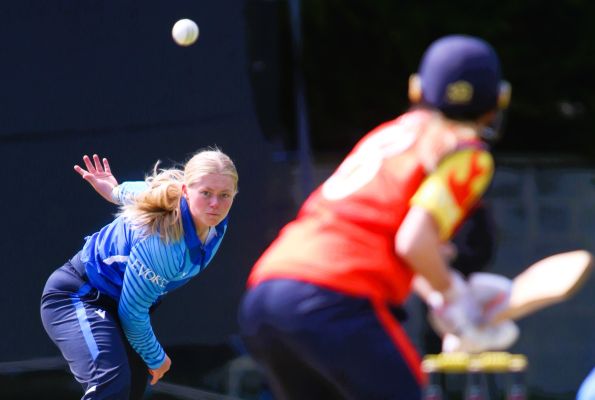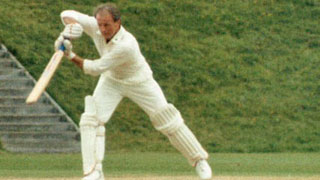Who would be a bowler?
Last Monday, I took myself off to Anglesea Road to see the Typhoons play the Scorchers in the final game in the Super 3 series. As is usual, I brought along the camera only to find that there were 3 other photographers on call - insert joke about more cameras than spectators..... Actually that is not true.
For these games there is a decent smattering of watchers, even if the majority had a relative of some sort playing. On a wander around the ground, I came across a knot of viewers, most of whom I know through cricket and have done so for some time whether through the family connection, children playing on rep teams together or youth cricket administration.
That was my connection to them but their connection to each other was that all 3 had a daughter playing for the Typhoons and all 3 daughters were spin bowlers. It occurred to me that theirs must be the most difficult role in the ground that day, that of the parent of a T20 bowler. Is there a collective noun for such a grouping, I wonder. A “tense” of parents, a “worry”, a “fret”, a “just smile and pretend it's ok” of parents. In modern day cricket, it's hard enough to be a bowler but a T20 spin bowler is positively gladiatorial.

Last Friday I was in Observatory Lane as The Students of Dublin University took on Leinster in their final Alan Murray T20 game. It was a hard watch. The shoe was on the other foot now, as DUCC’s offspinner is the youngest. He bowled really well, as a matter of fact, dismissing both openers in his spell. He suffered in one over, going for 15 as he told me “he missed his length”.
Leinster, like most grounds nowadays, seems smaller, too small for this type of game. The square boundaries are short and fast, making them extremely difficult to defend. Mishits race to the ropes. And in Leinster cricket they are certainly not the shortest. It was a bit depressing watching the batsmen go about their business.
The game plan seemed to be to swing and swing hard. I reckon it's a 55-60 metres hit to clear the ropes for a maximum but the balls were flying over the wall, over the protective nets, over the houses. It was ridiculous. It was boring. There is no premium for hitting the ball 20 metres further than the boundary but maybe there is a case for reducing the value of a 6, given that batters now have everything in their favour.

When the first bowling machine appeared in Castle Avenue, maybe 30 years ago, the late Podge Hughes was genuinely bemused. Why, he wondered, would you want a bowling machine when you had him to bowl at you? As the years went on (he never changed his view that a batter was always better facing a human rather than a machine) and the game swung to the batter’s favour he sarcastically suggested sticking a bowling machine at the bowling crease and let it do the work and take the punishment. He had a point and things are far worse now than when he made that comment.
The beauty of sport is in the contest. All sport. The 100 metres in an Olympic final, 8 runners crouched in a straight line, all waiting to run the same distance, first over the line is the hero, a fair and equal contest. Football, hockey, even teams, each with a goal to put the ball in the net, imagine if one team had a larger goal to defend. As a player, sport fulfills a number of motivations. Health, exercise, camaraderie, fun but crucially the test of yourself and your capabilities. I could add cash into that list but I will stay away from that topic today.
At some stage, someone, I have to presume that it was in the ICC decided that the game needed to change. Was this because cricket was now a product and what the public wanted to see was runs being scored, boundaries being hit, balls flying over stands and into the adjoining streets. Laws were changed. We have to go back to 1962 for the start of this process, when the No Ball law changed from a back foot law to a front foot law.
The same decade saw the start of the act of covering wickets. The first is obviously a Law change that operated world wide but the latter is something much more recent in local cricket falling under regulations rather than the Laws of the game. It doesn't seem that long ago that uncovered wickets were the norm and no I am not suggesting a return to uncovered wickets, however the covering of wickets along with the undoubted improvement in the quality of wickets, inevitably have led to a change in the balance between bat and ball.
That balance was further widened with the introduction of white balls which the bowler in the family tells me are significantly inferior to any red ball. No shine, no seam, no tools for the bowler to work with other than intelligence and prayer. On the other hand, bats have become mallets, huge chunks of dried wood. A decent thick edge will get you 4 with these monsters, swing a bit harder and 6 can be added to your score. The fielding side are restricted in where they can place their field, restricting the number of fielders outside the hallowed 30m circle, we have power plays, not 1 but 2. They introduced power surges recently, frankly I didn't care enough to find out what they are and still don’t
Yes, of course the game has changed, I understand that. Turn on the telly and there is a T20 series from somewhere on one of the many sports channels. As I write this, there is Major League Cricket in the US, Vitality Blast (Men and Women) in England, World Cup qualifiers in Holland and even in Bali where The Phillipines are taking on South Korea. How could I forget the 4th week (yes the 4th week) of the Interpro “Festival” in Dublin. Oh and sorry, did I forget to mention the Big Daddy of them all, the IPL though that might have finally come to a conclusion. So all over the world, batters with clefts of willow are whacking the ball out of the park as we all cheer on. Don’t we?
We have become so used to seeing the batters dominate that when scores are low, there is a sense of disappointment. The evolution of T20 has meant that scores of 130/140 were at the high end in the early years, a score now that would be seen as pretty poor. A Leinster player was quoted this week as saying that “With our batting line up, I think we can chase anything over two hundred”. Now that was a bit of a surprise, I’m sure that he didn't think that chasing 750 in 20 overs was realistic but hey you never know. What it does indicate is that the mindset of batters in T20 is just to go out and whack it, come what may. Strike rate rather than runs scored average is king.
So it’s all about the batters. Why? Perhaps the “Game” believes that everything is an IPL game, made for prime time viewing and who is going to watch a low scoring game, with batters struggling to score on low, difficult wickets, with the boundaries out at reasonable, defendable distances. Who? Me. The 2024 Women’s T20 World Cup is a case in point. Played in the UAE where wickets tend to be slower and lower, it was a much more even contest between bat and ball than normal. The highest score in the competition was 158, scored by the winners New Zealand in the final, while earlier Pakistan defended 116 against Sri Lanka. Was it less interesting than a boundary fest, not to me, no.
When I think of cricket and in particular watching cricket, a couple of things come straight to mind. Brian Lara, small, neat, high back lift, crashing the ball through point with just a flick of those wrists. Beautiful. David Gower, languidly at the crease, almost in slow motion, gently easing the ball through the covers with a little smile on his face. But also, I picture the thrilling sight of Jeff Thompson, javelin thrower, peppering English batsmen, making the unhelmeted batter hop while at the other end Dennis Lillee made fast bowling look like the most natural athletic performance.
Take your pick from the West Indies, Courtney Walsh, Andy Roberts, Malcolm Marshall, watching them bowl was a real joy. Speed, skill, threat, physical and mental. That's the quickies, you will never convince me that seeing someone stick their leg down the wicket and pump a ball over midwicket is more entertaining than watching Shane Warne weave some magic spell over a batter. Bowling is an integral and equal aspect of the game, it deserves more.
Bowlers have had to adapt, learn new tricks, change their mindset. A Dot ball is good news, full and wide is more effective than full and straight. Poor Podge, he wouldn't be able for this. Bowlers become experts in dark arts, using tricks like knuckle balls, slower ball bouncers, all designed to fool the batsman into mistiming the slog for the stands. If they can perfect it, happy days, trips around the world to play in the next franchise league for significantly more money and a fraction of the overs. Good luck to them, they deserve every penny.
Up in Bready recently when the Irish side took on the West Indies, Matthew Humphries destroyed all my arguments when he bowled his 4 overs for 16 runs taking 2 wickets in the process. A solid performance, you would think but when you consider that the other 16 overs bowled by the Irish team disappeared for 240 runs you realise that something was afoot. I think we all know that Humph was performing some form of voodoo in Maghermason that day, whether it was something he learned in the Maths Department in Trinity or the classrooms of Methody, we may never know, but it was a thing of beauty, the ball finally having its day, laughing at the bat as it passed unhindered.






